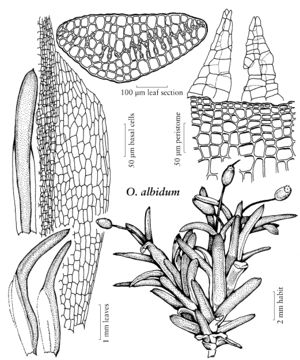FNA>Volume Importer |
imported>Volume Importer |
||
| (5 intermediate revisions by 2 users not shown) | |||
| Line 34: | Line 34: | ||
|family=Leucophanaceae | |family=Leucophanaceae | ||
|illustrator=Patricia M. Eckel | |illustrator=Patricia M. Eckel | ||
| + | |illustration copyright=Flora of North America Association | ||
|distribution=Worldwide in tropical and subtopical regions. | |distribution=Worldwide in tropical and subtopical regions. | ||
|reference=None | |reference=None | ||
| Line 39: | Line 40: | ||
|publication year= | |publication year= | ||
|special status= | |special status= | ||
| − | |source xml=https:// | + | |source xml=https://bitbucket.org/aafc-mbb/fna-data-curation/src/2e0870ddd59836b60bcf96646a41e87ea5a5943a/coarse_grained_fna_xml/V27/V27_980.xml |
}}<!-- | }}<!-- | ||
-->[[Category:Treatment]] | -->[[Category:Treatment]] | ||
Latest revision as of 21:29, 5 November 2020
Plants glossy or dull, white, whitish to glaucous green, purplish, or brownish, often with pink or red tinge below. Stems simple or forked; rhizoids brown, inconspicuous; axillary hairs slender, proximal cell elongate, with brownish walls. Leaves erect to spreading-recurved, ligulate to lanceolate from clasping base, multistratose above, border of elongate hyaline cells present or absent, with 1-stratose wings of lamina in base, largely composed of internally and externally porose hyaline empty cells, chlorophyllose cells in 1–3 internal layers, forming a network immersed among the hyaline cells; typical costa present or absent. Specialized asexual reproduction by 1-seriate gemmae borne at leaf tips. Sexual condition autoicous; perigonia numerous, minute, gemmiform, axillary, stalked, with a few highly reduced leaves. Perichaetia terminal, inconspicuous, leaves small, otherwise scarcely differentiated. Seta single, straight, smooth. Capsule erect, exserted; operculum obliquely rostrate; peristome single, of 8–16 linear to triangular, sometimes apparently multicellular teeth, the teeth single or all or partly paired, smooth or variously decorated, each tooth composed of an interior and an exterior layer of sometimes cell-like plates with thin or variously thickened walls, portions of the walls of the plates sometimes eroded away, prostome present or absent. Calyptra cucullate, smooth. Spores granular-papillose.
Distribution
Worldwide in tropical and subtopical regions.
Discussion
Genera 4 or 5, species ca. 34 (1 in the flora).
The multistratose “leucobryaceous” leaves of Octoblepharum, the sole representative of the family in the flora, may be taken to indicate its relationship with other mosses having similar leaves. But the distinctive peristome of Octoblepharum makes the genus difficult to classify in the Leucobryaceae, where it has traditionally been assigned, or in the Calymperaceae, where it has also been placed and from which it differs markedly in leaf structure. A. Eddy (1988+, vol. 2) assigned the genus to its own monogeneric family, Octoblepharaceae (illegitimate name), based on its peristome, but Octoblepharum seems best classified in the Leucophanaceae, where it was placed by M. Fleischer (1900–1922, vol. 1), along with three genera of similar mosses.
Selected References
None.
